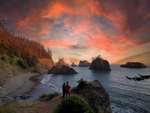The Hieroglyphic Trail in Arizona's Superstition Mountains combines beautiful Sonora Desert scenery with a glimpse into ancient history. One of the trail's most fascinating features is the collection of petroglyphs that can be found near its endpoint. The rock carvings, created by the Hohokam people over a thousand years ago, depict a variety of symbols, including animals, human figures, and geometric patterns, and provide a window into the lives and beliefs of the people who once inhabited the area.


Trailhead elevation 2,080'
Water seasonal pools at the petroglyphs
Don't miss the petroglyph groupings on the east side of the canyon
Hiking the Heiroglyphic Trail
At the end of E Cloudview Ave, a large parking lot marks the starting point for the hike. The lot tends to fill on the weekends, so hikers are encouraged to get an early start. Beyond the gate at the trailhead, the trail begins with a steep ascent, followed by a mix of flat stretches and moderate inclines.

As the trail nears the entrance of Hieroglyphic Canyon, the vegetation grows noticeably lusher, and the path becomes increasingly rocky.

Around 1.5 miles in, the trail reaches its main highlight. Above the seasonal pool, hikers will discover a wall of petroglyphs etched into the stone—easily visible and abundant.

On the western side of the canyon, the rock surfaces are adorned with depictions of human-like figures, animal shapes, and intricate geometric patterns.

The wall stretches over 100 feet in length and features nearly 150 distinct petroglyphs.

Hikers should avoid touching the images as they walk along the wall, as this can speed up the weathering process.

The depictions can be found on the surface that hikers walk on, at eye level, and far above.

Numerous large groupings are present, possibly symbolizing a ceremony or a significant gathering.

Some petroglyphs are clearly recognizable, while others are difficult to interpret. As with nearly all rock art, the original artist's intentions remain a mystery.

Depictions are also present at ground level, including a fascinating image, likely representing a shaman.

Concentric circles, likely representing the sun, can also be found throughout the area.

Additional petroglyphs are located on the east side of the canyon, just below eye level. Though often overlooked, they are among the most fascinating.

After exploring the area and discovering some of the hidden panels, hikers can retrace their steps to return to the trailhead.
_edited.png)









































Comentarios